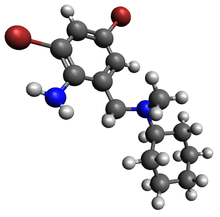Bromhexine: Difference between revisions
Reverted good faith edits by Sengsational (talk): A patent is not a secondary WP:SCIRS source |
→Experimental Antiviral Use: speculation based on primary research |
||
| Line 59: | Line 59: | ||
Bromhexine is contained in various formulations, high and low strength syrups 8 mg/5 ml, 4 mg/5 ml, tablets and soluble tablets (both with 8 mg bromhexine) and solution for oral use 10 mg/5 ml, adapted to the need of the patients. The [[posology]] varies with the age and weight, but there are products for all age groups from infant on. Bromhexine is well established and tolerated. |
Bromhexine is contained in various formulations, high and low strength syrups 8 mg/5 ml, 4 mg/5 ml, tablets and soluble tablets (both with 8 mg bromhexine) and solution for oral use 10 mg/5 ml, adapted to the need of the patients. The [[posology]] varies with the age and weight, but there are products for all age groups from infant on. Bromhexine is well established and tolerated. |
||
==Experimental Antiviral Use== |
|||
Some [[coronaviruses]], e.g. both the [[SARS-CoV|SARS coronavirus of 2003]] and the [[SARS-CoV-2]] which causes [[COVID-19]], are activated by [[TMPRSS2]] and can thus be inhibited by TMPRSS2 inhibitors.<ref name="Hoffmann_2020" /> "[[SARS-CoV-2]] uses the SARS-CoV receptor [[ACE2]] for entry and the serine protease TMPRSS2 for S protein priming<ref>{{cite journal | vauthors = Rahman N, Basharat Z, Yousuf M, Castaldo G, Rastrelli L, Khan H | title = Virtual screening of natural products against type II transmembrane serine protease (TMPRSS2), the priming agent of Coronavirus 2 (SARS-CoV-2) | journal = Molecules | volume = 25 | issue = 10 | pages = 2271 | date = May 2020 | pmid = 32408547 | pmc = 7287752 | doi = 10.3390/molecules25102271 }}</ref>. A TMPRSS2 inhibitor approved for clinical use blocked entry and might constitute a treatment option."<ref name="Hoffmann_2020">{{cite journal | vauthors = Hoffmann M, Kleine-Weber H, Schroeder S, Krüger N, Herrler T, Erichsen S, Schiergens TS, Herrler G, Wu NH, Nitsche A, Müller MA, Drosten C, Pöhlmann S | display-authors = 6 | title = SARS-CoV-2 Cell Entry Depends on ACE2 and TMPRSS2 and Is Blocked by a Clinically Proven Protease Inhibitor | journal = Cell | date = March 2020 | volume = 181 | issue = 2 | pages = 271–280.e8 | pmid = 32142651 | doi = 10.1016/j.cell.2020.02.052 | pmc = 7102627 | lay-url = https://www.dpz.eu/en/home/single-view/news/die-vermehrung-von-sars-coronavirus-2-im-menschen-verhindern.html | lay-source = Deutsches Primatenzentrum GmbH | doi-access = free }}</ref> Bromhexine is also one such experimental candidate as a TMPRSS2 inhibitor for potential use against both influenza and coronavirus infections in general, including those prior to the advent of [[COVID-19]]<ref name=Shen_2017>{{cite journal |last1=Shen |first1=Li Wen |last2=Mao |first2=Hui Juan |last3=Wu |first3=Yan Ling |last4=Tanaka |first4=Yoshimasa |last5=Zhang |first5=Wen |title=TMPRSS2: A potential target for treatment of influenza virus and coronavirus infections |journal=Biochimie |date=November 2017 |volume=142 |pages=1–10 |doi=10.1016/j.biochi.2017.07.016 |pmid=28778717 |pmc=7116903 }}</ref> as well as COVID-19 itself. <ref name=Depfenhart_2020>{{cite journal |last1=Depfenhart |first1=Markus |last2=de Villiers |first2=Danielle |last3=Lemperle |first3=Gottfried |last4=Meyer |first4=Markus |last5=Di Somma |first5=Salvatore |title=Potential new treatment strategies for COVID-19: is there a role for bromhexine as add-on therapy? |journal=Internal and Emergency Medicine |date=August 2020 |volume=15 |issue=5 |pages=801–812 |doi=10.1007/s11739-020-02383-3 |pmid=32458206 |s2cid=218877551 |doi-access=free }}</ref> |
|||
==Brand names== |
==Brand names== |
||
Revision as of 23:19, 1 October 2020
This article needs additional citations for verification. (July 2012) |
 | |
 | |
| Clinical data | |
|---|---|
| AHFS/Drugs.com | International Drug Names |
| Pregnancy category |
|
| ATC code | |
| Legal status | |
| Legal status |
|
| Pharmacokinetic data | |
| Bioavailability | 75-80% |
| Elimination half-life | 12 hr |
| Identifiers | |
| |
| CAS Number | |
| PubChem CID | |
| DrugBank | |
| ChemSpider | |
| UNII | |
| KEGG | |
| ChEBI | |
| ChEMBL | |
| CompTox Dashboard (EPA) | |
| ECHA InfoCard | 100.020.622 |
| Chemical and physical data | |
| Formula | C14H20Br2N2 |
| Molar mass | 376.136 g·mol−1 |
| 3D model (JSmol) | |
| |
| |
| | |
Bromhexine is a mucolytic drug used in the treatment of respiratory disorders associated with viscid or excessive mucus.[1]
It was patented in 1961 and came into medical use in 1966.[2]
Function
Bromhexine is intended to support the body's mechanisms for clearing mucus from the respiratory tract. It is secretolytic, increasing the production of serous mucus in the respiratory tract, which makes the phlegm thinner and less viscous. This contributes to a secretomotoric effect, allowing the cilia to more easily transport the phlegm out of the lungs. For this reason it is often added to cough syrups.
It has been shown to increase the proportion of serous bronchial secretion, making it more easily expectorated. It is indicated as "secretolytic therapy in bronchopulmonary diseases associated with abnormal mucus secretion and impaired mucus transport".
Bromhexine is contained in various formulations, high and low strength syrups 8 mg/5 ml, 4 mg/5 ml, tablets and soluble tablets (both with 8 mg bromhexine) and solution for oral use 10 mg/5 ml, adapted to the need of the patients. The posology varies with the age and weight, but there are products for all age groups from infant on. Bromhexine is well established and tolerated.
Brand names
- Broncholyte Elixir
- Bisolvon
- Paxirasol
- Barkacin
- Bromhexin
- Vasican
- Bisolex
- Robitussin Chesty/Forte
- Duro-Tuss Chesty/Forte
- Benadryl Chesty/Forte
- Movex
- Bromex
- Solvex
- Mucolyte
- Brofentol
- Brofentol Plus
- Dysolvon
- Flegamina
- Ventilate Forte (combination of bromhexine and salbutamol)
- Cofdex
References
- ^ Morton, Ian; Hall, Judith (1999). Concise Dictionary of Pharmacological Agents. Springer. p. 55. ISBN 0-7514-0499-3. Retrieved 2009-06-03.
- ^ Fischer, Jnos; Ganellin, C. Robin (2006). Analogue-based Drug Discovery. John Wiley & Sons. p. 544. ISBN 9783527607495.
